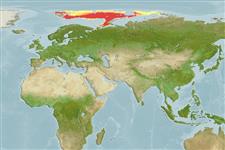>
Perciformes/Zoarcoidei (Eelpouts and pricklebacks) >
Zoarcidae (Eelpouts) > Gymnelinae
Etymology: Gymnelus: Gymnelus, derived from Greek, gymnēlos (Latinized Greek) = poor, needy (akin to Greek gymnos for destitute (E. Spencer, pers.comm. 09/13); andersoni: Named for M.E. Anderson (Ref. 60485).
More on author: Chernova.
Issue
Also classified in Gymnelus retrodorsalis (M.E. Anderson; Ref. 51665).
Environment: milieu / climate zone / depth range / distribution range
Ekologi
marina djupbottenlevande; djupintervall 27 - 300 m (Ref. 30485), usually 52 - 300 m (Ref. 30485). Deep-water
Arctic: Spitsbergen (Sturfjord at 108-121 m); north, central and eastern parts of the Barents Sea (91-300m); off Nova Zemlya and in the Kara Sea; in the Shokalskii Straight and western part of the Laptev Sea (27-196 m).
Size / Vikt / Age
Maturity: Lm ? range ? - ? cm
Max length : 14.0 cm TL hane/ej könsbestämd; (Ref. 30485); 13.2 cm TL (female)
Prefers silty sand bottom. Adults found at depths of (27) 52-300 m; juveniles at shallow depths. Usually at temperatures below -1.0°C and in one case, in the Barents Sea at 280 m, under +1.0°C and salinity of catch locations often not less than 34 ppt.
Life cycle and mating behavior
Könsmognad | Reproduktion | Lek | Ägg | Fecundity | Larver
Chernova, N.V., 1998. A new species Gymnelus andersoni sp. nova, from the Arctic Seas with refinement of the species status of G. retrodorsalis Le Danois and G. paciporus Anderson (Fam. Zoarcidae). J. Ichthyol. 38(2):708-715. (Ref. 30485)
IUCN Red List Status (Ref. 130435: Version 2024-1)
Threat to humans
Harmless
Human uses
Verktyg
Special reports
Download XML
Internet-källor
Estimates based on models
Phylogenetic diversity index (Ref.
82804): PD
50 = 0.5002 [Uniqueness, from 0.5 = low to 2.0 = high].
Bayesian length-weight: a=0.01000 (0.00244 - 0.04107), b=3.04 (2.81 - 3.27), in cm total length, based on all LWR estimates for this body shape (Ref.
93245).
Trofisk nivå (Ref.
69278): 3.1 ±0.3 se; based on size and trophs of closest relatives
Resiliens (Ref.
120179): Mellan, lägsta populationsfördubblingstid 1,4-4,4 år (Assuming tmax>3).
Fishing Vulnerability (Ref.
59153): Low vulnerability (10 of 100).
